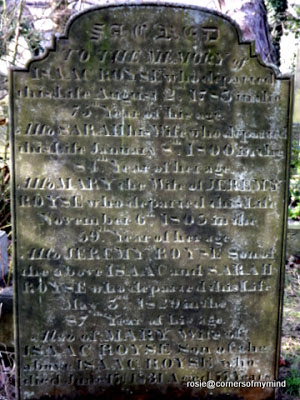As promised a couple of posts ago I've now written a separate post about St Edmund's church in Castleton. The church stands just off the main street close to the old market building and on the way up to the path leading to Peveril Castle.
We spent ages wandering around the church yard reading the memorial inscriptions looking for Paul's ancestors without success. There were several generations of the same families all close together.
There was also lots of wildlife in the church yard, it was only after I'd taken this photo that I saw the little bird sitting on a branch, it might be a wren.
Some inscriptions were a dream for family historians with loads of information etched into the stone
Others were small and simple and gave the bare minimum of information. I guess in 1822 everyone would have known who MR was.
Inside, the church was bathed in sunlight with shadows and reflections filtering across the floor and onto the wooden pew doors.
There were some lovely stained glass windows in the chancel
The large window is above the altar and the one below to the right of the altar.
The other windows had lovely coloured glass around their edges and it was these that were reflecting across the floor. I loved the brass oil lamps with engraved glass globes attached to the pews.
The hatchment below is for Frances Mary, sister of the Reverend Frederick Farran who was Vicar of Castleton from 1780 to 1817. She married a Captain George James Hamilton and died in 1820.
I was intrigued by the names carved onto the doors of the box pews. Each pew was owned by a different family. There were two Robert Halls the one below from 1676 and an earlier one of 1663.
The brass plaque over the carved name is I Royse and its date is 1822. On the stone memorial pictured above are several Royse family members including two Isaacs, father and son, the second died in 1831 aged 77 so this box pew could have been his.
The church, which was restored in 1837, is the focus of the Castleton Garland Day festival which is held on 29th May also known as Oak Apple Day. This was a celebration of the escape of Charles II from the parliamentarian forces after the battle of Worcester in 1651 when he is said to have hidden in the branches of an oak tree at Boscobel house in Shropshire on 29th May which was also his birthday. When he was restored to the throne in 1660 the 29th May was declared a national holiday to celebrate his safe return. It is possible that the Garland Day festival dates back to much earlier times but it is now associated with Oak Apple Day.
It struck me that the dates on these pews of 1661 and 1662 were of the
time of the Restoration and that the Cresswell, Hall and Cryer families may have joined in
those new oak apple and garland day celebrations.













Lovely post Rosie. I love all the history of some of these old churches. Your photos are wonderful and I do like the stained glass and its reflection.
ReplyDeletePatricia x
Thanks, Patricia - I was very struck by the light patterns and reflections in the church:)
DeleteI really enjoyed reading this post. I visited this church years ago and in the pouring rain. It was lovely to see the sun shining through the windows in your photos! Jx
ReplyDeleteGlad you enjoyed the post, Jan, perhaps you will visit again one day in the sunshine:)
DeleteThe carved names are wonderful, aren't they? What a different era, eh? I love seeing light through stained glass windows - it's so pretty. Have a good week. Abby x
ReplyDeleteHope you too have a good week, Abby, the names make you think about who the people were and what their life was like then:)
DeleteIt is a lovely church Rosie. I like to read inscriptions on gravestones but very often they have been weathered away. I like the little humble stone inscribed M R. x
ReplyDeleteI like the simple stones, Simone - I wonder if that was all they wanted or if it was all they could afford:)
DeleteWhat a charming church. I love seing the light coming in through stained glass windows too.
ReplyDeleteJune
It was lovely, June - so simple inside but so full of history:)
DeleteYour post was wonderful.
ReplyDeleteGlad you enjoyed it, Ruth:)
DeleteWhat a beautiful little church and so much history - if only the walls could speak.
ReplyDeleteIf only, Elaine - what stories we would hear:)
DeleteYou had a good, sunny day for your visit unlike when we went a little while ago. The stained glass window reflection in the floor looks
ReplyDeletebeautiful. It was so dark when we went we must go back and look at the
carving on the pews and spend more time in the churchyard.
The sun made such a difference, I expect the dark wood could make the interior quite dull in bad weather. The carving was fascinating, I'd like to go back and explore more:)
DeleteHow fascinating that there are people and stories here, connected to the time of the Restoration. I do love to see box pews in a church - and these ones are carved with names, which makes them special.
ReplyDeleteIt was quite poignant to see the names inside and outside the church. Record of living people who had been there and were now at rest:)
DeleteWas baptised confirmed and married in this cnnurch
ReplyDeleteHow lovely, it's such an interesting church and village. Perhaps you are still in the area?:)
Delete